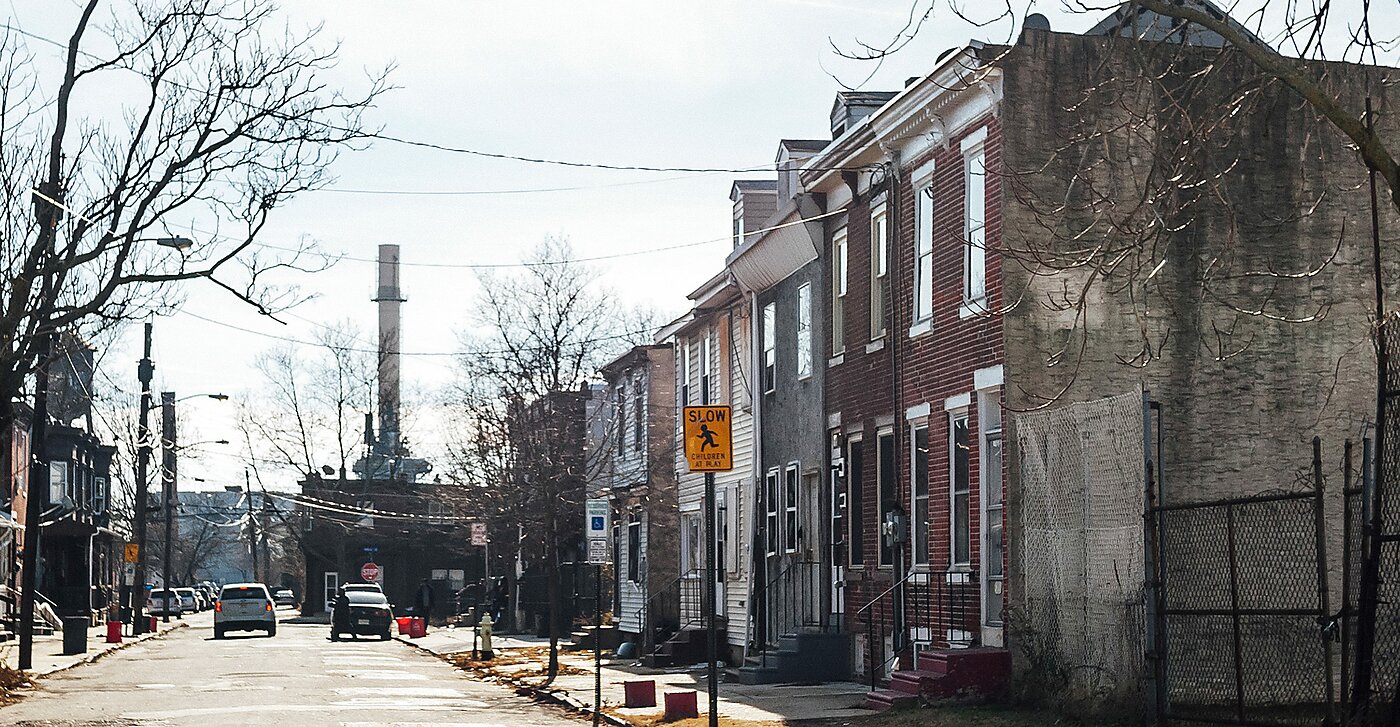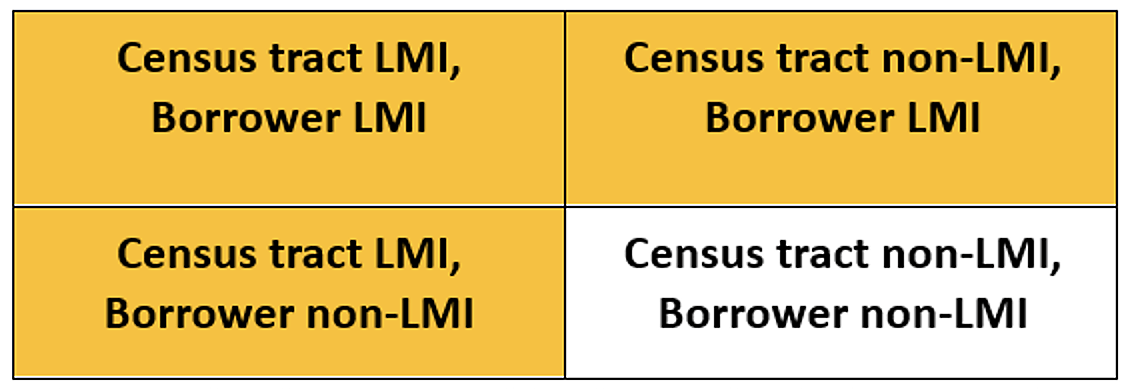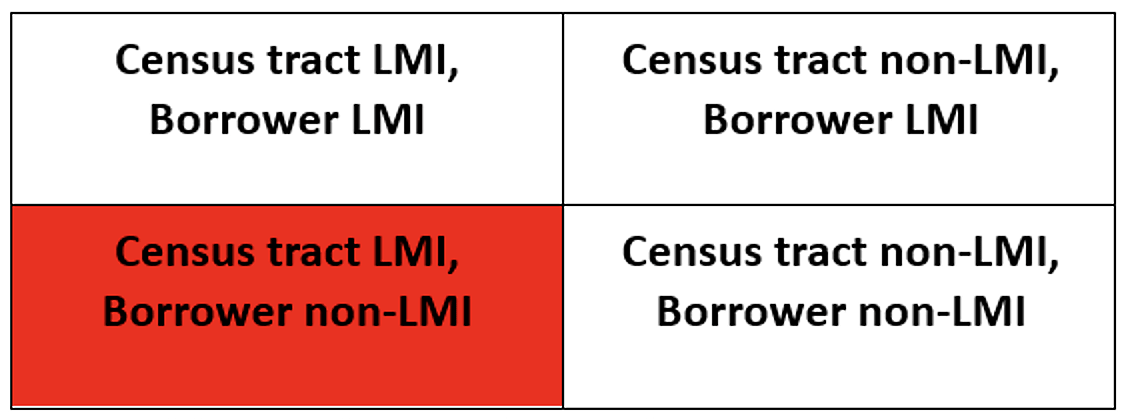In the Washington Post this summer, I reported findings (from a forthcoming paper with Andrew Forrester) that more than two-thirds of recent home mortgages in the District of Columbia for which banks can get CRA points went to high- rather than low-income borrowers. This is because current CRA regulations count loans to low-income borrowers and loans made in low-income census tracts (Figure 1a). D.C. has rapidly gentrified in recent years, as young professionals flocked into historically low-income neighborhoods, and many among these “gentrifiers” have bought homes. At present, CRA regulators take loans to gentrifiers into account when they evaluate banks, even though gentrifiers are not usually underserved borrowers.
Figure 1a: Loans to Low-Income Borrowers and in Low-Income Census Tracts Qualify for CRA Points
Gentrification, as a rule, is a good thing for both new arrivals and historic residents. A recent paper from the Federal Reserve Bank of Philadelphia finds that gentrification benefits the original residents of low-income neighborhoods. While more-educated homeowners seem to gain most, even renters and the less-educated are better off as a result of the improved living conditions and increased opportunity that gentrification brings about. The impact of gentrification on migration by less-educated renters, arguably the most vulnerable group, to other neighborhoods is relatively small: 4 to 6 percentage points.
The Philly Fed paper uses data from the 100 largest metropolitan statistical areas (MSAs), which needless to say differ widely in their local zoning laws, economic policies, history of segregation and discrimination, and other traits important for our analysis. It may well be that particular MSAs have worse outcomes from gentrification, for example, because zoning restrictions make it difficult for housing supply to respond to higher demand, causing displaced renters to face greater cost pressures and longer commutes. That, however, is not a direct consequence of gentrification but of local housing policy.
Regardless of one’s views on the desirability of rapid neighborhood change, there is wide agreement that government policy should not promote gentrification. High-income young professionals have the means to buy a home. Besides, the excitement of moving to an up-and-coming neighborhood and the lure of capital gains provide ample incentive for many of them to do so.
Moreover, in specific instances, there may be displacement of poorer (often minority) original residents, throwing into question the desirability of government helping to accelerate an inevitable development. For D.C., Andrew and I found that the minority share of a census tract’s population had declined by three percentage points for every additional percentage point of CRA-eligible lending between 2012 and 2017. That does not mean the CRA caused the displacement, nor does it negate other benefits of gentrification. But it should help persuade policymakers that counting gentrifier mortgages for CRA purposes is unnecessary if not outright harmful (Figure 1b).
Figure 1b: Loans to High-Income “Gentrifiers” Currently Count for Banks’ CRA Evaluations
That is why I have praised Comptroller of the Currency Joseph Otting and Federal Deposit Insurance Corporation Chairman Jelena McWilliams’ decision to no longer count gentrifier loans in banks’ CRA evaluations. Their proposal, unveiled in December, says the following about gentrifier mortgagers:
Although the agencies remain committed to encouraging banks to meet the credit needs in LMI areas, for banks evaluated under the general performance standards, the proposal would not apply a geographic distribution test to a bank’s consumer and home mortgage product lines. Under the geographic distribution test in the current CRA framework, banks receive positive consideration for home mortgage and consumer loans made in LMI areas, even if they are made to middle- or upper-income individuals or families. Unlike small loans to businesses and small loans to farms in LMI areas that may result in additional job creation or other positive effects for the larger community, home mortgage and consumer loans to middle- or upper-income individuals and families in LMI areas are generally not as beneficial to LMI communities and may result in displacement. Accordingly, this proposal would not apply the geographic distribution test to these banks’ home mortgage and consumer product lines. The result of this is that under the proposal, a mortgage loan to a high-income individual living in a low-income census tract would no longer qualify for CRA credit.
Otting and McWilliams are right. In the 1970s context of urban flight and decline, encouraging mortgages to high earners in low-income neighborhoods might have helped stem their migration to the suburbs---although the impact can only have been marginal, and the dramatic drop in house prices was the more meaningful spur for ambitious buyers. But those circumstances no longer apply. Instead, many large MSAs are changing rapidly, with a growing number of residents finding it hard to afford to live in them.
Ahead of Wednesday’s House Financial Services Committee hearing with Comptroller of the Currency Joseph Otting, Andrew and I have expanded our analysis to the five most-populated MSAs in the country: New York, Los Angeles, Chicago, Dallas, and Houston. We suspected our finding for D.C., that a large share of CRA-eligible 1-to 4-family (known as single-family) mortgages go to gentrifiers, would also apply to these MSAs. But, because gentrification in D.C. has been more rapid, and the original residents’ starting position arguably more precarious, we also anticipated a weaker gentrifier bias for other MSAs.
Table 1 lays out our findings. Three patterns are worth highlighting. The first is the substantial share of gentrifier mortgages in all CRA-eligible mortgages for all five MSAs, despite significant variation between them. The second is a steady increase in the share of gentrifier mortgages in the five years from 2012 to 2017. The third pattern is the large difference in gentrifier loans between New York and three of the four other MSAs, with L.A. somewhere in the middle but converging with New York more recently.
Table 1. Share of CRA-Eligible Single-Family Mortgages to High-Income Borrowers, by MSA and Year (%)
As we suspected, D.C. has an even greater share of gentrifier loans than other MSAs. This may be due to idiosyncratic economic factors related to the District’s profound, decades-long decline and its swift rebirth since the mid-2000s. Alternatively, Andrew and I only looked at mortgages in D.C. proper, rather than for the whole metropolitan area (which includes Arlington and Alexandria), which may bias our results since much recent gentrification has focused on the District – although some parts of Arlington have also undergone great change during this time period.
I can only speculate about the differences between New York and L.A., the Texas MSAs, and Chicago. Texas is known for its relatively flexible zoning rules, which help call forth new supply in response to housing demand, lowering prices and making homeownership more affordable to low-income families. Chicago's experience may have more to do with the city’s rising crime rate and the state of Illinois' economic underperformance since the 2008 recession ended. New York and L.A., on the other hand, are high-cost cities whose zoning codes appear to make housing needlessly unaffordable.
Comptroller Otting and Chairman McWilliams' proposal to stop counting high-income mortgages under a statute that aims at helping the underserved will not, on its own, make housing more affordable in America’s biggest cities. But it will focus CRA regulations on the borrowers for whose sake it was enacted, while helping researchers answer the most important policy question regarding this 42-year-old law: does it in fact encourage banks to lend without increasing risk?





